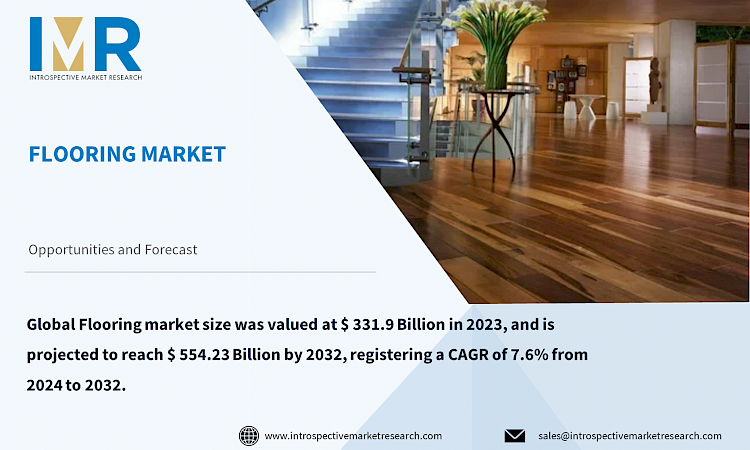
According to a new report published by Introspective Market Research, titled, ?Flooring Market by Type, Resilient, Carpets & Rugs, End-use: Global Opportunity Analysis and Industry Forecast, 2024?2032,?
Global Flooring market size was valued at $ 331.9 Billion in 2023, and is projected to reach $ 554.23 Billion by 2032, registering a CAGR of 7.6% from 2024 to 2032.
The manufacture, distribution, and consumption of many materials and products used to improve and coat indoor and outdoor surfaces are all included in the flooring market. This covers carpeting, ceramic tiles, vinyl, hardwood, laminate, and other materials intended for use in commercial, industrial, and residential settings. Consumer awareness and regulatory pressures are driving a transition in the flooring sector towards sustainable and eco-friendly materials.
For example, bamboo flooring is becoming more and more popular because of its eco-friendliness and durability. It is manufactured from renewable resources. The market is divided into three sectors: residential, commercial, and industrial. Luxury vinyl tiles (LVT) are gaining popularity in residential spaces due to their affordability and realistic appearance, which imitate stone or hardwood floors.
As the world's population continues to grow, more residential, commercial, and industrial development projects are being undertaken. The requirement for flooring solutions, from contemporary options like luxury vinyl tiles (LVT) and epoxy coatings to more conventional materials like hardwood and tiles, is commensurate with the number of buildings that are being constructed. The use of ecologically friendly flooring materials has increased due to the growing emphasis on sustainability and eco-friendly building techniques. For example, bamboo flooring is becoming more and more popular because it is renewable and has less of an impact on the environment than hardwood.
The rising number of homes and businesses are being built in cities to meet the expanding population. High-rise residential buildings are becoming more common in densely populated urban centers, and as cities grow, there is a constant need for flooring solutions that offer durability, aesthetic appeal, and functionality to meet the diverse needs of modern living. These buildings frequently require flooring materials that can withstand heavy foot traffic, are easy to maintain, and have sound insulation qualities. Because of this, materials with a wide range of styles, affordability, and durability such as laminate flooring, engineered hardwood, and luxury vinyl tiles (LVT) are becoming more and more popular.
Global Flooring Market, Segmentation
The Flooring market is segmented on the basis of Type, End-Use, and region.
Type:
The type segment is further classified into Non-Resilient (Ceramic, Wood, Laminate, and Others), Resilient (Vinyl [Luxury Vinyl Tiles, Vinyl Composite Tiles, and Vinyl Sheet Flooring], Rubber, Linoleum, and Cork), Carpets & Rugs, (Tufted, Woven, and Others)). Among these, the Ceramic Flooring sub-segment accounted for the highest market share in 2023. A rising number of homes and businesses are being built in cities to meet the expanding population. High-rise residential buildings are becoming more common in densely populated urban centers, and as cities grow, there is a constant need for flooring solutions that offer durability, aesthetic appeal, and functionality to meet the diverse needs of modern living. These buildings frequently require flooring materials that can withstand heavy foot traffic, are easy to maintain, and have sound insulation qualities.
End-Use:
The application segment is further classified into Residential, Commercial, and Industrial. Among these, the Residential sub-segment is anticipated to show the fastest growth by 2032. Because so many homes need flooring solutions, the residential sector is the one with the biggest consumer base for flooring products. This category includes single-family homes, apartments, and other residential places where flooring is a critical component that improves appearance, comfort, and usefulness.
Region:
The Flooring market in Asia-Pacific is projected to show the fastest growth by 2032. ? A considerable number of people have moved into cities as a result of widespread urbanization in major economies like China, India, and Southeast Asian countries. The construction industry is fueled by this shift in demographics, which increases demand for flooring solutions for homes and businesses. For instance, as more people move to China's cities, the number of residential development projects is increasing, necessitating the use of premium flooring materials to satisfy the demands of contemporary living areas.
Some of the leading Flooring market players are
- Mohawk Industries, Inc. (US)
- AFI Licensing (US)
- Burke Flooring Products, Inc. (US)
- Shaw Industries, Inc. (US)
- Interface, Inc. (US)
- Mannington Mills Inc. (US)
- Crossville Inc. (US)
- Tarkett, S.A. (France)
- Gerflor (France)
- Firbo Flooring (China), and Other Active Players.
Key Industry Developments
- In March 2023, Shaw Industries Group, Inc. declared its collaboration with Encina to recycle waste produced during the carpet production process. Shaw Industries will give Encina more than USD 2.5 million worth of garbage annually. Through the cooperation, the former will be able to reduce its carbon footprint and greenhouse gas emissions, helping the company to meet its sustainability goal.
- In January 2023, Interface, Inc. introduced the FLOR brand, a new line of carpet tiles for the winter. The collection features fresh hues and designs that give a room coziness and coziness. The collection is also long-lasting, easily cleaned, and replaceable.
Key Findings of the Study / Key Industry Developments.
- Shift to environmentally friendly and sustainable materials, driven by consumer awareness and governmental pressure.
- Ceramic flooring is the industry leader due to its strength and visual appeal, particularly in residential high-rise structures.
- The residential category is growing at the quickest rate, and flooring plays a crucial role in improving utility, comfort, and look.




